Oh, to have a front-row seat to the inner-workings of a Highly Sensitive Person’s mind! To watch the curtain rise on a sensory production of thoughts, feelings, and ideas would be magical. Perhaps at times exhausting. But then, the exhaustive nature of the HSP’s brain is part of its identity, even its genius. And finding creative HSP coping strategies to calm the highly sensitive brain is an ongoing pursuit, winding through an array of constant stimulation.

The link between creativity and high sensitivity is so strong that each personality trait, in many ways, predicts the other.
And that should come as no surprise, given that both creativity and high sensitivity are sensory-immersive “experiences.”
It is, after all, the awareness, processing, and emotional experience of environmental (both inner- and outer-) stimuli that defines HSPs.
High Sensitivity, Creativity, and the Big 5 Personality Types
In the field of psychology, there is a system of personality testing called the “Big Five” traits (remembered by the acronym OCEAN):
- Openness to Experiences: imaginative, curious, open-minded; appreciative of the arts and creation; open to new ideas and experiences
- Conscientiousness: self-disciplined, organized, striving for measurable achievement
- Extraversion: outgoing, assertive
- Agreeableness: friendly, compassionate
- Neuroticism: vulnerable to negative emotions like depression, anxiety, and anger; intolerant of stress; emotionally unstable
Interestingly, high sensitivity is associated with specific aspects of Neuroticism and Openness to Experiences, namely: anxiety and vulnerability for Neuroticism and artistic interest, imagination, and emotionality for Openness to Experiences.

Creativity is most highly associated with Openness to Experiences, especially as it relates to imagination, curiosity, appreciation of the arts, and new ideas. Research has shown creatives to be more autonomous, introverted, independent, and innovative, as well.
Yes, this is only a cursory look at the similarities between high sensitivity and creativity. But, for the purpose of finding creative ways to calm down the HSP brain, it offers a unique perspective.
That is: The creativity that is innate to high sensitivity can be the HSP’s greatest asset for self-calming.
10 Creative HSP Coping Strategies
There is an unfortunate myth that creativity requires complete innovation with no reliance on past accomplishments. The artist or inventor is supposed to pull ideas out of thin air or dreams during REM sleep. Otherwise, the finished product and its process don’t count. (This is not actually true!)

But creativity in all its forms is about connecting dots and seeing relationships and possibilities. The present builds upon the past. The future is inspired by the present.

And HSPs and creatives are naturals at making those connections.
Their minds are melting pots of sensory and emotional details, constantly processing, cataloging, and connecting experiences to emotions and visionary possibilities.
And, for every HSP who feels alone and/or misunderstood in an overstimulating, insensitive world, their creativity is a faithful friend.
Below are 10 creative HSP coping strategies
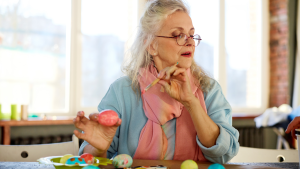
-
Arts and crafts:
Whether you are a doodler or Da Vinci, making art has profound benefits across the board.
For one, it lowers stress (e.g. reduced cortisol levels).
It draws you away from outside chaos and into a focused “flow state,” creating a state of mindfulness.
Making art also allows you to process your emotions.
HSPs are constantly processing information, much of which is emotion-based. And art, through its physical “dot-connecting” and mindfulness, allows emotions to breathe into their own placement and resolution.
Making art activates several parts of the brain, including reward pathways and areas dedicated to problem-solving and divergent thinking.
And, finally, it provides a judgment-free zone for HSPs who are prone to people-pleasing and perfectionism.
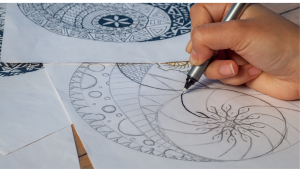

-
Zentangles and Mandalas:
In the Zentangle Method, you create beautiful images by drawing smaller, structured patterns called tangles. And you create the tangles with “Elemental Strokes” (dots, lines, simple curves, S-curves, and orbs).
Zentangle art is non-representational and has no “right” or “wrong.”
As a matter of fact, Zentangle kits intentionally don’t include erasers, as no mark is considered a “mistake.” No erasers in life; no erasers in Zentangle. What a beautiful, inviting philosophy, especially for people like HSPs who are prone to perfectionism and sensitive to criticism.
The method is known for reducing stress and increasing creative flow and self-confidence. The repetitive nature of drawing serves to distract the mind from anxious thoughts and helps it to focus on calming things.
Mandala coloring has similar benefits to the Zentangle Method, but involves coloring intricate circular patterns called mandalas.
In the Sanskrit language, “mandala” means “circle” or “center.” These circles, which bloom outward in various patterns, are spiritual symbols in Hinduism and Buddhism.
As you color, you receive the benefits of reduced stress, blood pressure, and negative thinking. You also receive a boost to your immune system and creativity and experience benefits similar to meditation.

-
Solo nature-walk with photography:
HSPs, by their very nature, need personal downtime to neurologically “recharge.” And that goes for extraverted HSPs as much as for the more common introverted HSPs.
Sometimes that may involve a dark, quiet room while the rest of the world bustles outside. But, as a creative way to calm the highly sensitive mind, time with Mother Nature can be incredibly restorative. And you don’t have to head to the National Parks to reap the benefits.
The purpose is to immerse your senses in natural wonders: dappled light, chirping birds, swaying branches, colorful foliage.
Research shows that even 90 minutes in nature reduces activity in the brain responsible for negative thinking.
By taking your (phone) camera along, you can up your creative game by actively looking for moments and memories to create.
You will delve deeper into the nuances of the sun’s shifting light as the day progresses. You will feel the moods of nature differently as you photograph into the light and away from it.
And you will return home not only refreshed, but with photos you can incorporate into other creative projects.
Have a well-behaved canine companion? The company of a loyal, non-judgmental companion not only reduces stress and elicits joy. But few things are more beautiful against a natural backdrop than a happy, content dog.

-
Music:
Nothing sets a mood like music. It can energize, motivate, inspire, unite, uplift, evoke, enamor, calm, and relax.
And the reasons are based in the biology and physiology of the brain.
For HSPs, the connection to music is especially profound. Their brains show higher activation in the reward center, as well as in the areas that control social functioning.
In other words, music can give an HSP who desires and/or needs alone-time a sense of social connection, even empathy.
Consider making your own playlist of favorite music that calms your mind and simply makes you feel good.

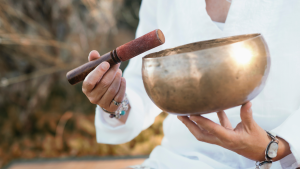
-
Sound bath:
The meditative practice of sound baths is growing in popularity.
Participants gravitate toward it, in part, because they can let go of the “intellectualizing” that often interferes with meditation. They can simply “bathe” in the sounds and vibrations that are orchestrated by the sound-bath practitioner.
Recipients say they experience deep relaxation – often to a depth never before experienced – and come away with renewed energy. (For an explanation and demonstration of several types of sound-bath instruments, view here.)
As a creative way to calm the highly sensitive brain, a sound bath allows you to draw into yourself. Even in a group setting, you have no expectations placed on you other than to be open and receive. How incredibly nurturing.
Perhaps you can’t afford the in-person experience or simply want to benefit from a sound bath in privacy. Apps like The Sound Bath will treat you to the tones and frequencies of crystal bowls, gongs, and other meditative instruments.

Physical movement opens up a world of benefits for everybody and every body. Our bodies were designed to move, which is another way of saying that movement is a good thing.
Both dance and yoga, as different as they may be, emphasize the mind-body (and breath) connection. For HSPs, this is especially important, as we have such fine-tuned awareness of our inner- and outer-environments.
Making connections is what we do; so having a physical way to express our own mind-body connection is important and liberating.
Physical benefits abound, of course: cardiovascular health, flexibility, strength, coordination, balance. But then there is the boost in mood from dopamine and natural pain-killing endorphins.
And dance, unlike most other forms of exercise, offers an outlet for emotional expression.
Don’t feel comfortable in a dance class with other people? Turn on that happy playlist you created and “dance your feelings” right at home. Or turn on a YouTube yoga video and practice poses that feel good to you.

If you have never tried writing with your non-dominant hand, you may be surprised at its power.
We become so accustomed to experiencing and responding to life from a dominant-hand and dominant-hemisphere perspective.
By writing with your non-dominant (usually left) hand, you awaken your intuitive, emotional side and give it permission to speak. And that can be a real Whoa! experience if you have been keeping anxiety and other challenging emotions bottled up inside.
One impactful journaling exercise is to use your dominant hand to write guiding questions and supportive responses to your non-dominant hand.
Think of your non-dominant side as your inner-child and your dominant side as your adult. Let your “child” write its fears and concerns with your non-dominant hand. Then respond with gentle inquiries and support with your dominant hand.
Not only is it eye-opening to realize how long your inner-child has been crying out for attention and reassurance. But it’s empowering to realize that your adult can answer and meet her needs.
For HSPs, who innately have high emotional responsiveness and empathy, this can be a grounding practice. It can help keep them in touch with their intuitive, wise, and creative sides while avoiding overwhelm.
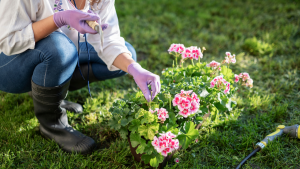
-
Gardening:
You don’t have to have acreage to have a garden. The idea is to get lost in the timelessness, rhythm, resilience, and surprises of nature.
Get your hands into the soil to welcome spring. Create a garden-patio with potted plants. Take a leap with hydroponic gardening and grow some of your own herbs and vegetables.
Gardening, like painting, can help you disconnect from the chaos of the world by drawing your focus into something essential and rewarding. And it offers you the opportunity to express yourself with whimsy and imperfection, which feels like kindness to a highly sensitive soul.
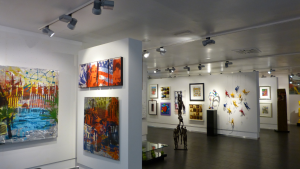
-
Take yourself on an artist’s date:
When’s the last time you scheduled a date with only your curious, exploratory self?
You don’t have to consider yourself an artist to take yourself on an artist’s date. Just set out to experience art and creativity with eyes and heart wide open.
Take in an art museum or gallery. Linger by pieces of art that speak to you and listen to what they are trying to say. Chances are they were created by other HSPs like you.
Take a walk and photograph graffiti and interesting microcosms that most people don’t notice.
Stop in a thrift store and let your mind imagine how a discarded item could be turned into a treasure.
The point is, spend time nurturing your creative impulses. Give them the opportunity to explore and imagine without prediction or expectations.
And enjoy feeling the self-validation that comes from honoring that life-giving part of who you are.

-
Daydream:
Believe it or not, daydreaming can be a wonderful way to discard anxiety.
If you have difficulty falling asleep, turn the page in your mind to one of pure imagination.
What if I won the lottery and could do anything I wanted? What would I do? Where would I go? Whom would I help?
What can I paint on that extra canvas in the garage?
I know I’m an adult, but what do I really want to be when I grow up?
It may sound like flooding an already overloaded brain; but daydreaming without assignment of expectation can be very relaxing…and fun.
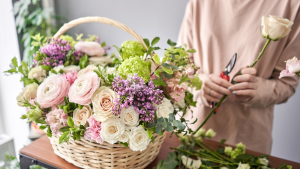

Using Your Innate Gift To Manage Your Highly Sensitive Brain
Creativity is a spark that enters the world with every one of us. But for Highly Sensitive People, that spark becomes more like a flame. It can’t help itself.
For the highly sensitive brain that is already so prone to anxiety, that innate creativity can be a saving grace.

From problem-solving to creating beauty to finding outlets for emotional expression, creativity is a conduit of calm for the highly sensitive brain.
Dr. Elayne Daniels is a Boston area psychologist, consultant, and international coach whose passion is to help people celebrate their High Sensitivity…and shine their light. To read more about High Sensitivity, check out some blogs here.
